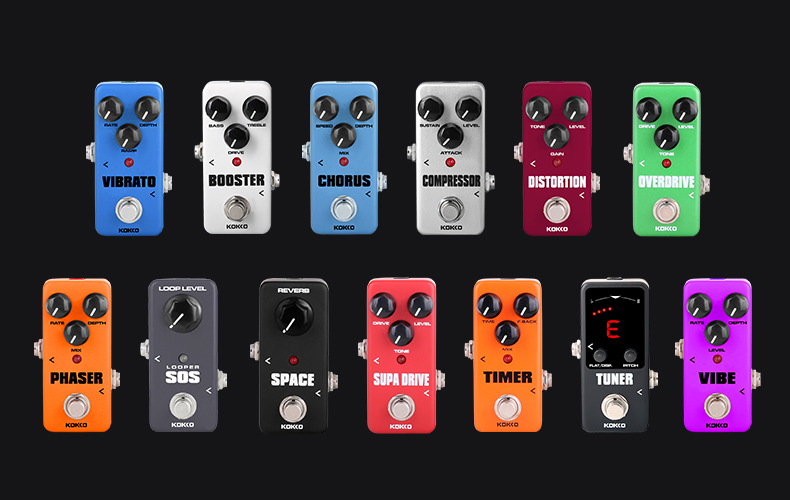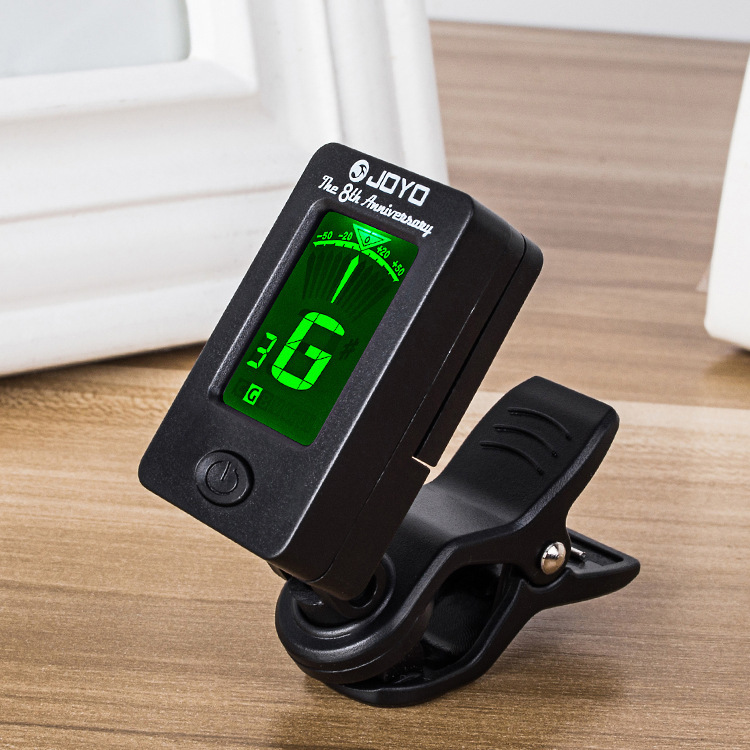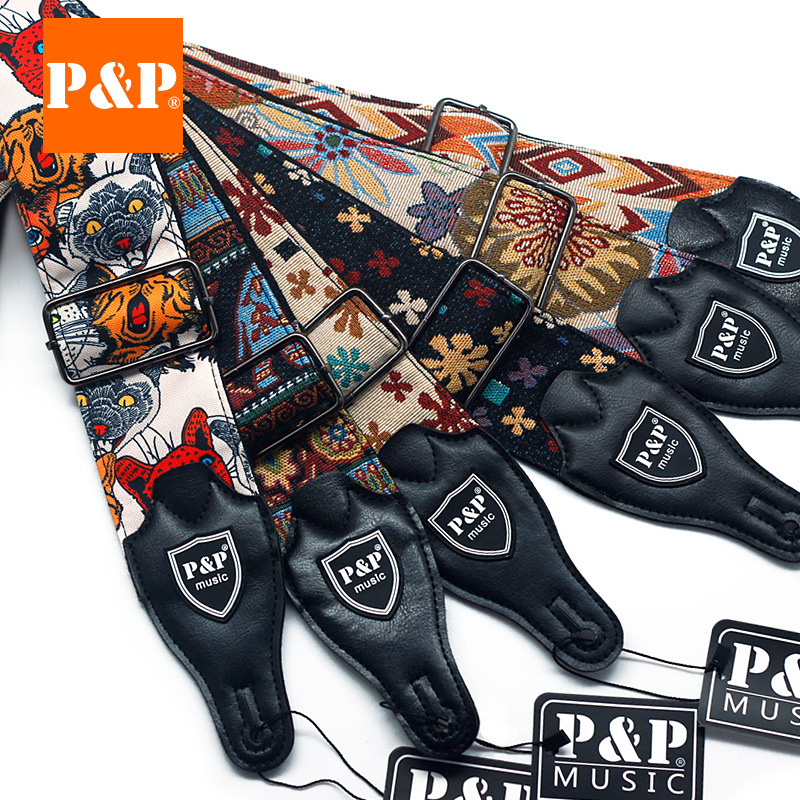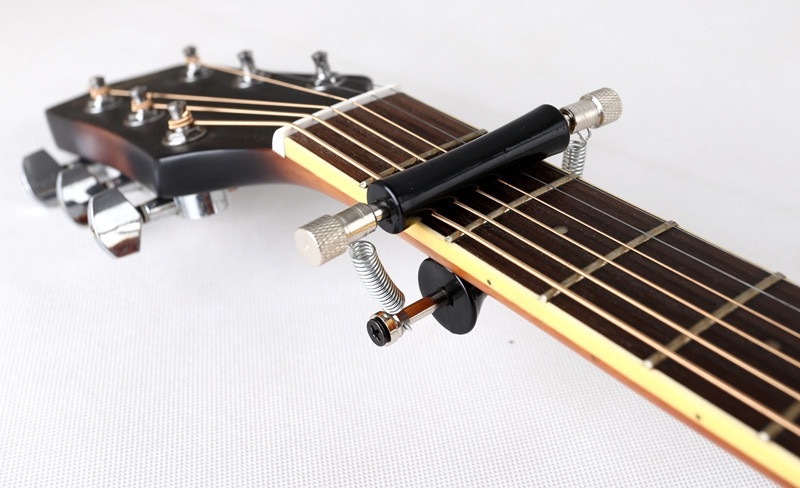剛剛開始玩電吉他的你可能不清楚需要什麼配件,你手上只是有Pick,音箱和一支電吉他。其實還有很多的配件幫助你玩得更有樂趣和更有技巧。這一節部落格介紹五種常見的電吉他配件。
1.效果器
吉他效果器在電吉他新手看來是一種神秘的東西,常常看台上的偶像電吉他手突然之間就能把吉他音色變得很搖滾/很迷離/很空曠,這些都是一塊塊或者綜合的效果器造成的,電吉他手只需要輕輕一踩就能把自己想要的效果器啟動,把吉他音色變了身。以下我們會介紹一些常見的效果器讓大家認知一下。

調音效果器
調音效果器顧名思義就是幫助電吉他調音,他能在你彈奏之前確保你的吉他已經在合適的音,當然你也可以使用夾體版的調音器但是調音效果器的好處是非常準確
破音效果器(Distortion)
破音是把吉他的音增幅,造成一個扭曲/震撼效果,音的持久性會增加。這是電吉他手solo時常用的效果,會增加聽眾的注意力。常見的破音/失真效果有Fuzz,Stomp 等等
過載效果器(Overdrive)
過載效果器是較輕微的破音/失真,效果會增加音量和溫暖度,常見的有Crunch 這一類幫你吉他音色加辣或增加“不乾淨”的效果
混響效果器(Reverb)
混響效果器是增加電吉他的空間感的效果,一般叫Hall Effect,讓你彈奏的音質好像在廣闊的大球場或者在細小的房間,都是很不一樣的味道
延遲效果器(Delay)
延遲效果就是把吉他的聲音像回音一樣重複,和混響相似的能增加空間感。
2.調音器

開始玩電吉他的時候,拿上手發覺掃弦的音很奇怪,明明上次有調好音,原來吉他的弦會因為天氣溫度還有生鏽度而改變張力,從而影響音準。
你需要的是一個調音器,夾在你的電吉他上,調好你的電吉他:EADGBE
這樣你掃弦,玩solo,還有退弦也不會發現走音了
但是調音器還是有很多款的:
– 半音階 vs 非半音階的調音器
半音階調音器顧名思義能夠調整吉他音到半音階的程度,比如說你能把E 調到 E#, 或者Eb
非半音階的調音器就不能做到這一點的啦
– 夾子調音器
夾子調音器有自己的儀器測試夾在樂器上彈奏的震動,憑著微小的震動去判斷音準
-調音效果器
在效果器的一節中提過的調音器,重點是你需要Jack 線插到這個調音器的Input, Output到下一個效果器或者到Amplifier
這樣你就能在顯示屏上看到你的彈奏音準不準
-Polyphonic 調音器
這是比較新穎的調音器,吉他手可以一次過掃弦看到每條弦的音準同時調音。這是調音效果器的一種
3.電吉他弦
電吉他弦的選擇也是很多新手電吉他手需要摸索的一個天地。
-電吉他弦有不同的粗度(Gauge)
和木吉他弦一樣,電吉他弦有不同的Gauge,比較小數值的Gauge 像09|42 聲音比較單薄,但彈奏是反應可以靈敏點,退弦較容易不花力氣
如果選擇10|46或者數值更高的,聲音通常比較厚實,而且配合不同的弦科技可以讓音色變得更飽更溫暖,適合玩爵士樂
-電吉他弦纏繞種類
電吉他弦可以有不同的纏繞,比如說Roundwound 就是較粗的456弦有細線圍繞著核心弦,而Flatwound 就是表面在鍍上一層金屬薄片讓表面平滑,彈奏的音色更圓潤溫暖
-電吉他弦的材料
有分Nickel 和Nickel-Plated 這些分類,Nickel的音色會比較溫暖,Nickel-Plated 的音色比較亮麗
4.吉他帶

如果你玩電吉他,大部分上台演出都是站在台上,就算樂隊排練你有大部分時間都是站著。因此你需要一條好用而又漂亮的吉他帶讓你的排練或表演更加有型,舒適。選擇吉他帶時候又有什麼需要留意呢?
-吉他帶的材料
一般吉他帶都是用皮革做的,也有用純棉做的,圖案可以是刺繡的。如果你長時間在站著而背負著很重的電吉他或貝斯,你需要的是能減少肩膀壓力,較厚的吉他帶
-吉他帶的長度寬度
一般吉他帶都是能調整長度的,40-60英吋的長度是最常見的,貝斯手有些用70英吋長的帶,因為很多貝斯/電吉他手都喜歡背得很低很低啦!!
但你需要確保吉他的高度不會讓你彈奏受影響喔
5.吉他變調夾

變調夾(Capo)是很多吉他手使用的工具,用來隨時把彈奏的Key升高。讓你繼續用C調的Chord去玩不同Key的歌。
其實Capo也有很多種的,除了我們常見的還有以下:
-Rolling Capo/ Slider
Rolling Capo是可以在指板上調整夾住的品的變調夾,意思是你可以隨意在彈奏期間敏捷地再升降Key,有聽Sungha Jung -My Heart Will Go On 一曲你就能開聽到他神奇的再透過Rolling Capo升調
——————————————————————————————————————————————————-
Some guitar accessories will undoubtedly require other optional items that will make your life easier. In this session, I'd like to provide you with some guidance on all of these topics. It's a good idea to sort these out at some time, but you don't have to do so before you get started—all you actually need is a guitar and some picks to get started.
If you play Electric Guitar, there are a few items you'll want to buy from Six Months Rebellion Music to play your music sweetly.
1. Pedals
Guitars have more accessories than almost anything else on the earth, so it's easy to become lost.
Pedals, like different guitars, have distinct timbres and tones – and using them successfully allows you as a guitarist to make an idea or song really stand out.

Organize your guitar effects with these pedalboards that fit any budget.
Tuner Pedal
A tuner pedal is unquestionably the most vital item to have on your pedalboard, despite its dull appearance. You'll sound terrible no matter how good the rest of your pedals are if you're not in tune!
Distortion Pedal
Getting a separate pedal may not be essential if you already have an amp with a built-in distortion channel. On the other hand, a distortion stompbox will cause havoc if your amp only has one channel or can't produce a lot of gain.
Overdrive Pedal
When it comes to sound, there's a fine line between distortion and overdrive. Simply enough, a distortion pedal produces a lot of dirt, but an overdrive pedal produces a low-gain crunch. The sheer number of overdrive pedals available will astound you, just like their distortion counterparts. However, several well-known models have led the way for years, if not decades.
Reverb Pedal
You won't need a reverb pedal if your amp already has the effect built-in, just like you won't need a distortion pedal (not in terms of how it sounds!). If not, this type of pedal will add melodic space and richness to your sound.
A reverb pedal, for example, simulates the echo that occurs when a sound is produced in a big space, such as a hall. Reverb is commonly employed in music production. A reverb pedal will deepen your guitar's sound by adding an ambient trail, which is especially effective when used with clean amp settings.
Delay Pedal
A delay pedal, like reverb, is a time-based effect that repeats your guitar sound. While that description may not sound attractive, a delay pedal is difficult to top as a creative instrument.
2. TUNER
It's essential to tune up your guitar! When you're starting to play, it's easy to be discouraged when you strum a chord, and everything sounds incorrect. This can be due to poor technique; it is more typically due to the guitar being out of tune. A guitar tuner is must-have equipment, especially when starting because you need to know that if your playing isn't sounding correct, it's because of you, not your instrument. Because there are so many different guitar tuners to choose from, we've put together this guide to help you figure out which one is right for you.

The term "chromatic tuner" is the first source of potential misunderstanding. This can be found on some tuners, but not all. What exactly does this imply? A non-chromatic guitar tuner, on the other hand, is solely designed to tune a guitar in standard EADGBE tuning. For example, when you play a low E, the tuner should recognize that you're trying to tune that string and indicate how sharp or flat it regards the note E. The tuning of a chromatic tuner is shown about the nearest semi-tone (i.e., the nearest note in the chromatic scale). This implies you may tune to various guitar tunings or tune instruments other than a guitar using a chromatic tuner.
The most common guitar tuners are compact 'box' models with a built-in microphone for tuning acoustic guitars and a jack input for tuning electric guitars. The operation of a clip-on tuner is slightly different. It contains a built-in contact microphone. This is capable of detecting very low-level vibrations.
While clip-on guitar tuners may be more handy for acoustic guitar players, pedal tuners are designed for guitarists who utilize amplifiers to play electric or electro-acoustic guitars. These are housed in a chassis that resembles a guitar effects pedal, but they lack a built-in microphone and rely on the player to connect the guitar to it through a jack connection.
Polyphonic tuners are a relative innovation in the world of guitars. With their Polytune pedal, TC Electronics was the first to introduce the technology. Stand guitar tuners let the user tune a guitar one string at a time. In contrast, a polyphonic tuner allows the musician to strum the open strings while simultaneously viewing the individual tuning of each string.
3. STRINGS
Electric guitar strings come in a variety of gauges or thicknesses. In addition to other aspects like string material, the thickness of an electric guitar string has a significant impact on playability and sound.
-
Choosing the best strings is a difficulty faced by all guitarists and bassists. D'Addario and Elixir are two of the best string producers, but which is the greatest?
-
When picking between the two, you must take into account several things. Guitarists and bassists demand three traits from their strings: tone, feel, and durability.
-
D'Addario's XL strings are a fantastic choice if you desire a deep, warm tone. On the other hand, Elixir creates strings that are both smooth and sensitive, with a sharp attack.
4. STRAP
Do you need a guitar strap for your electric guitar? Which one do you think you should pick? A guitar strap is a musical device that attaches to a guitar and keeps it securely on the guitarist's body while performing. It's critical to choose the correct electric guitar strap before making a purchase.

-
There are many different guitar straps, each with its own material, breadth, and padding. Leather with an extra shoulder cushion attachment is the most comfortable.
-
Although a wide guitar strap may handle a large instrument well, you may want to consider a strap with additional soft cushioning to relieve pressure and strain on your shoulder.
-
A normal guitar strap is between 40 and 60 inches long. People recommend that if you play bass, you wear a strap that is roughly 70 inches long.
-
Guitar straps are typically 2 inches wide on the thin side of the guitar and 4 inches wide on the thick side.
5. CAPO
A capo is a tiny clamp that is attached to the fretboard of a guitar. As a result, the strings are barred, resulting in a lower string length. That is to say; it raises the pitch of the instrument. It's very simple to use a capo; all you have to do is clip it onto whichever fret you want and start playing!
There are numerous different varieties of capos, and each one produces a different set of sounds. Capos are good to have on hand so you can try new things. A capo is a terrific gadget to acquire if you have a string instrument and want to mess around with the pitch. Let's take a look at the five most prevalent capos and their functions.

-
A clamp capo – The clamp capo is the most common capo on the market. It clamps onto the guitar's neck, simultaneously barring all six strings, and it may be readily withdrawn. It will almost always have a spring mechanism.
-
A Glider Capo - like the picture shown above it is a capo that can slide from fret to fret during the song, which is for changing key during a song easily.




